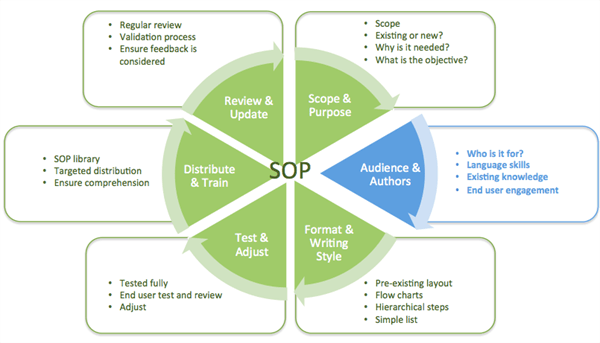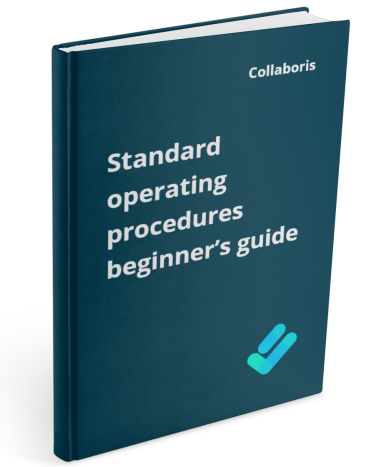Policy Approval Workflow Automated policy approval workflows offer several benefits that can significantly enhance ...
Standard Operating Procedures Guide – Audience and Authors
Welcome back to the third in our series of blogs describing the Key elements in the SOP lifecycle. So far we have introduced the ‘SOP pie’ and discussed Scope & Purpose. This blog will dig further into the 2nd slice – Audience and Authors

So let’s start with Audience
This is an area that is often not considered when creating and updating SOP’s. During the Scope and Purpose stage you should have already identified your audience at a high level. Now when moving into that SOP we need to dig a little further and understand that target audience in more detail.
- Does the audience have differing language skills?... These could be subtle variations in language skills through to having different nationalities. Often a way to accommodate these challenges is the use of pictures.
- Do they have varying needs from the SOP?... Before we put pen to paper and start moving into the Format and Writing style section, identify if the audience of this SOP falls into more than one group of people. E.g. The team leader or a section in a factory may be interested in slightly different parts of the same SOP to that of the team members doing the hands on work. Make a note of those groups and some of their different requirements and use this to feed into the creation of the SOP.
- What are their knowledge levels?... Again before we put pen to paper, and at most stages of the SOP lifecycle, we need to review and give considerations to the knowledge levels of the groups of people within our audience.
Are your policies read on time and by the right people?
DocRead makes compliance simple
Onto Authors
Remember just because you have been given the responsibility to create the SOP, it may not mean that you are the correct person to write it. Similarly whilst a head office team or committee may have triggered the need for the SOP, they are often not the correct people either. Identifying the most appropriate person is rarely simple, so here are some tips to help:
- Who is doing this activity now? – They need to be consulted at the very least, and are prime candidates to be one of the Author team.
- Who has the knowledge on how it should be done at a local level? – So this could be the same person as above or could be the local expert on this process or product.
- Consider the site and location? - If the same SOP is to be implemented at different sites, then people from each site will need to be involved as contributors, you may well need to have slightly different SOP’s at each site.
- Collaboration Method - All the authors involved will need to be able to work collaboratively on its creation and will need a means of doing this. SharePoint would be the perfect tool for this...take a look at this blog on using SharePoint for SOP's
It goes without saying that as well as these points above we need to consider all we have learnt about the SOP and its audiences so far in the process. Even if our choice of author is limited due to real world constraints, at least if we consider these points we are heading in the right direction for a successful and workable SOP.
Get your free Standard Operating Procedures guide
Creating Standard Operating Procedures for your organisation doesn't have to be complicated. This guide will introduce you to the whole lifecycle from creation to training and distribution.
Other articles in the series:
You may also like:
Creating policy review reminders in Office 365 You might want to set up a ...
Podcast: Implementing effective healthcare procedures Implementing effective healthcare procedures is an ongoing process. It ...
Podcast: 10 Powerful Strategies for Employee ComplianceOrganizations face challenges in ensuring employee compliance with ...
AI Warns About Itself: How I Asked AI to Create a Podcast on the ...
Benefits of writing SOP's In any organization, standard operating procedures (SOPs) are critical to ...

